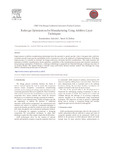JavaScript is disabled for your browser. Some features of this site may not work without it.
| dc.contributor.author | Salonitis, Konstantinos | |
| dc.contributor.author | Al Zarban, Saeed | |
| dc.date.accessioned | 2016-12-16T09:58:52Z | |
| dc.date.available | 2016-12-16T09:58:52Z | |
| dc.date.issued | 2015-09-30 | |
| dc.identifier.citation | Salonitis K, Al Zarban S, Redesign optimization for manufacturing using additive layer techniques, Procedia CIRP, Volume 36, 2015, Pages 193-198: CIRP 25th Design Conference Innovative Product Creation, 2-4 March 2015, Haifa, Israel | en_UK |
| dc.identifier.issn | 2212-8271 | |
| dc.identifier.uri | http://dx.doi.org/10.1016/j.procir.2015.01.058 | |
| dc.identifier.uri | https://dspace.lib.cranfield.ac.uk/handle/1826/11160 | |
| dc.description.abstract | Improvements in additive manufacturing technologies have the potential to greatly provide value to designers that could also contribute towards improving the sustainability levels of products as well as the production of lightweight products. With these improvements, it is possible to eliminate the design restrictions previously faced by manufacturers. This study examines the principles of additive manufacturing, design guidelines, capabilities of the manufacturing processes and structural optimisation using topology optimisation. Furthermore, a redesign methodology is proposed and illustrated through a redesign case study of an existing bracket. The optimal design is selected using multi-criteria decision analysis method. The challenges for using additive manufacturing technologies are discussed. | en_UK |
| dc.language.iso | en | en_UK |
| dc.publisher | Elsevier | en_UK |
| dc.rights | 2212-8271 © 2015 The Authors. Published by Elsevier B.V. This is an open access article under the CC BY-NC-ND license (http://creativecommons.org/licenses/by-nc-nd/4.0/). Peer-review under responsibility of the scientific committee of the CIRP 25th Design Conference Innovative Product Creation doi:10.1016/j.procir.2015.01.058 Attribution-Non-Commercial-No Derivatives 3.0 Unported (CC BY-NC-ND 3.0). You are free to: Share — copy and redistribute the material in any medium or format. The licensor cannot revoke these freedoms as long as you follow the license terms. Under the following terms: Attribution — You must give appropriate credit, provide a link to the license, and indicate if changes were made. You may do so in any reasonable manner, but not in any way that suggests the licensor endorses you or your use. Information: Non-Commercial — You may not use the material for commercial purposes. No Derivatives — If you remix, transform, or build upon the material, you may not distribute the modified material. No additional restrictions — You may not apply legal terms or technological measures that legally restrict others from doing anything the license permits. | |
| dc.subject | Design for additive manufacturing | en_UK |
| dc.subject | desing optimization | en_UK |
| dc.subject | additive manufacturing | en_UK |
| dc.subject | redesign | en_UK |
| dc.title | Redesign optimization for manufacturing using additive layer techniques | en_UK |
| dc.type | Article | en_UK |
Files in this item
This item appears in the following Collection(s)
-
Staff publications (SATM) [4365]
